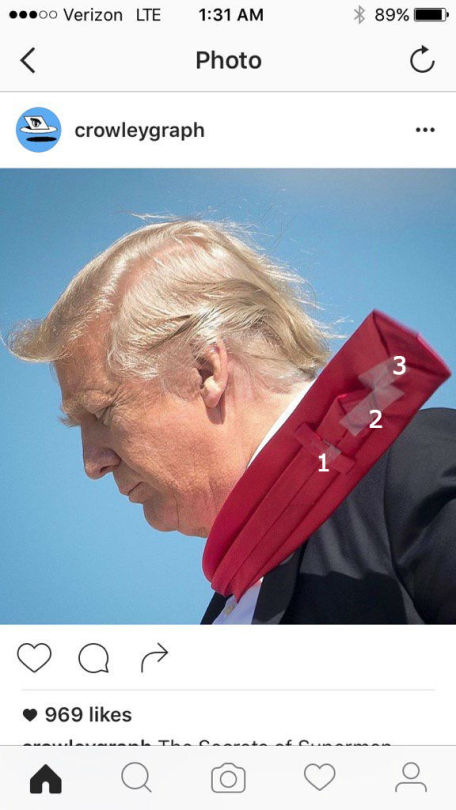Donald Trump is the most powerful man in the world. Among his lifelong struggles is his quest to keep his necktie in place, even as his surroundings spin into turmoil. Trump’s primary weapon in this battle against the forces of nature is scotch tape.
The above photo, taken by Stephen Crowley, gives us an extraordinary inside look at Trump’s methods. As you can see, Trump uses not two pieces of tape, as has been previously reported, but three:

Here is Trump’s strategy, such as I understand it. Piece 2 is to tape the skinny end of the tie to the wide end of the tie. It’s unclear to me why the keeper loop is insufficient to hold the skinny end in place, but I guess that’s one of the many reasons I’m not President. In any case, this ambiguity leads me to call Piece 2 the Puzzle Piece.
Piece 3 serves two functions. It both reinforces Piece 2′s hold on the wide end of the tie, while simultaneously holding closed the folds on the underside of the same wide end. I will call this the Side Piece.
And then Piece 1, the Piece de Resistance, wrapped around the tie’s keeper. This must be either a two-sided piece of tape, or if it be one-sided, looped with the sticky side facing out. This adhesive would ideally attach the tie to the shirt front, to keep the tie from flapping around, as it is doing in this photograph. It’s possible that the Puzzle Piece and the Side Piece are also double sided, in which case they could also contribute to this cause, but given where they are placed and the usual length that Trump ties his tie, it would not be the shirt that these Pieces would be grabbing onto.
There’s a story from World War II that has become something of a legend in classes on statistics and inference. The Air Force noticed certain parts of returning planes that were more likely to feature bullet holes. The Air Force at first thought,”well, here are the places we get hit the most often - we should reinforce those.” Of course this was exactly the wrong inference - the better places to reinforce would be the places where the planes that didn’t return were hit. Reinforcing the places where the returning planes were hit was exactly the wrong strategy.
Perhaps I’m making a similar error in my analysis of Trump’s taping game. We only get to see the great man’s failures - perhaps the mornings where he ran out of tape before getting to the sixth and seventh pieces that would have held his tie firm, its underpinnings shielded from the scrutiny of Instagram posts. There is a danger that, like the Air Force, we learn the wrong lessons by seeing only stories with one ending, forgetting that there are other stories - possibly with happier endings - that have not yet been told. But until such time as these great successes are declassified, we have only these fleeting, flapping moments on which to gaze, to ruminate, to marvel.